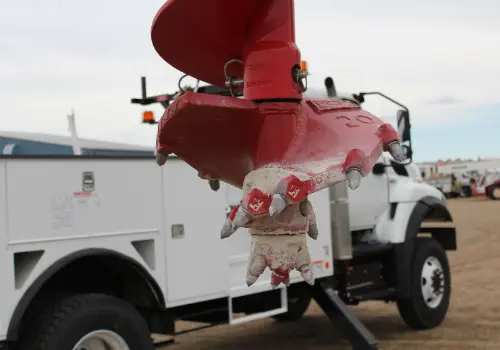TIPS FOR CHOOSING THE RIGHT DIGGER DERRICK AUGER TOOL FOR THE JOB

You can drill dirt with a rock auger or barrel tool, but you can’t cut rock efficiently with a dirt auger. While that maxim is an over simplification of how to select the right auger tool for a digger derrick, it’s a good rule of thumb. Electrical utilities and utility contractors must often make decisions on site about the best equipment for the job.
Boring reports provide some insight into the geological makeup of the ground, but the reality is that the conditions can vary dramatically between locations that are just a few feet apart. Understanding the differences between different types of auger tools can make the job go faster. As the ground conditions change, be prepared to switch tools to match the situation.
THE RIGHT TOOL FOR THE JOB
Augers have flights to lift the spoils that are loosened by the teeth and a pilot bit that stabilizes the drilling process for a straight hole. Core barrels cut a single track, applying more pressure per tooth, removing rock materials by lifting out the material as individual plugs. In most ground conditions, it’s best to start with an auger tool first, until you reach a point where it is not efficient, or it meets refusal to advance because the strata is too hard. At that point, it may be necessary to switch to a core barrel tool for better production. If you must start with a core barrel tool, on a digger derrick, you may need to use a pilot bit to hold the tool straight while starting the hole.
The type of teeth on the tool’s pilot bit is directly related to the application it’s designed to work in. The pilot bit and the flighting teeth should be compatible, with the same strength and cutting characteristics. Other specifications that are important in selecting the tool are auger length, flight length, flight thickness, and flight pitch. Various auger lengths are available to allow operators to fit the tool to the available tool clearance on your specific auger drill device or the digger derrick configuration.
Flight length is the auger’s total spiral length. The longer the flight length, the more material you can lift out of the ground. Long flight length is good for loose or sandy soil. Flight thickness impacts the strength of the tool. The thicker the tool flights, the heavier, so it’s beneficial to choose only what you need in order to maximize payload on the truck for road travel and amount of material lifted; to remain with the capacity of the boom. Terex recommends a thicker flight at the bottom of an auger for heavy duty applications.
Flight pitch is the distance between each spiral of the flighting. Too steep of a flight pitch, with loose soil, will allow the material to slide right back into the hole. In that situation, a flatter pitch would be more effective. But a steeper pitch will get the job done more quickly when the material is denser. Terex recommends a steep pitch auger tool for wet, muddy, or sticky clay conditions, as it’s easier to remove the material from the auger once lifted out of the hole.
At any time when the auger tool meets refusal, it’s a good time to switch to a core barrel style instead. By design, a core barrel single track cuts through hard surfaces better than multiple tracks produced by a flighted tool. When drilling through hard rock, such as granite or basalt, slow and easy is the best approach. You’ve got to be patient and let the tool do the work.
Some conditions, such as ground water, warrant specialized tools like drill buckets, often called mud buckets. These tools remove fluid/ semi fluid material from the drilled shaft when material does not adhere to auger flighting. Terex offers several styles, including Spin-Bottom and Dump-Bottom. Both are efficient methods for removing wet soil and the selection of one over the other often depends on the preference of the user. Another often-overlooked condition is frozen ground and permafrost, which is very abrasive. In this situation, a bullet tooth spiral rock auger is able to work efficiently.
ADDITIONAL RESOURCES AND SELECTION FACTORS
To illustrate the importance of matching the right tool to the task, Terex Utilities offers this video, which provides a side-by-side comparison of its TXC Auger and BTA Spiral with carbide bullet teeth drilling into the concrete. The TXC is best for loose, compacted soils; stiff clays, shale, cobbles, and medium rock strata. It’s not designed for cutting through concrete or hard rock. In contrast, the BTA Spiral is efficient for drilling into hard rock and concrete. After about 12 minutes, there is a drastic contrast in the amount of work accomplished by the BTA Spiral.
You can also refer to the manufacturer’s specifications. Most tools will include a description of the type of applications for which it is designed. Remember, selection factors include auger style tools or barrel tools, various types of teeth, and multiple tool sizes. With the right tool, you can reduce dig time, eliminate overheating, and improve productivity.
Your email address will not be published. Required fields are marked with *

